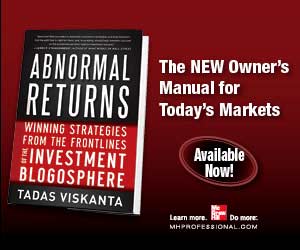|
Page 1 of 2
 The founder of one of
our favorite blogs, AbnormalReturns.com, has written a book under the same
name. In a clear and direct fashion, without excessive detail, he covers all
the basics of the field of investing. And, strangely enough, despite its title,
the book does not downplay the challenges of successful active investing.
Instead, much of the book explains the advantages for most individual investors
of a long term, index approach to investing. The founder of one of
our favorite blogs, AbnormalReturns.com, has written a book under the same
name. In a clear and direct fashion, without excessive detail, he covers all
the basics of the field of investing. And, strangely enough, despite its title,
the book does not downplay the challenges of successful active investing.
Instead, much of the book explains the advantages for most individual investors
of a long term, index approach to investing.
Introduction
The book by Tadas Viskanta
lists (p. 67)
7 basic do’s and don’ts of successful investing: allocation, diversification,
rebalancing, not ignoring performance, avoiding investments you do not understand, avoiding leverage, and avoid
illiquid assets. Useful, straightforward information which sounds non-controversial,
but the most interesting sections of the book also identify areas of investing that
are counterintuitive, the challenges of active investing, and other helpful
advice. Here is a brief overview, but we encourage our readers to buy and read
this book and follow the author’s blog
of the same name.
Appearances can be deceiving
Investing and the
markets are based on numerous assertions, many of which turn out to be incorrect,
questionable or difficult to quantify. Here are examples from the book.
-
Every investor has
heard his broker say that a particular investment is too risky. But Viskanta explains (p.2-) that finance academics and
market professionals actually define risk as a measure of volatility or price
fluctuation, up or down, quite different from the individual investor’s
understanding of risk as a measure of potential loss.
- Market participants measure
fixed income risk in relation to US
treasury bonds which they describe as risk-free, but in fact no security
is truly risk free when one considers potential losses when the value of any security
can decline when measured in other currencies, or as a result of inflation and/or
taxes (p.5,6 ).
- You often hear about
the
 equity risk premium (the fact riskier investments should merit a compensating
higher rate of return) as if it were gospel truth , but there is a surprising
lack of agreement when one tries to quantify this premium, and it can change
significantly over time (p.22-25). equity risk premium (the fact riskier investments should merit a compensating
higher rate of return) as if it were gospel truth , but there is a surprising
lack of agreement when one tries to quantify this premium, and it can change
significantly over time (p.22-25).
- If one believes in efficient
markets one should also probably believe momentum (the phenomena that hot
stocks are more likely to rise further than other stocks) does not exist, but
studies indicate it is alive and kicking. But it is hard to understand why, and
if it ever became so simple that anyone can do it, the returns might disappear
over time, so what should investors do (p.28-31). Other examples of
observations difficult to reconcile with efficient markets: the low risk anomaly- lower risk stocks tend to
outperform higher-risk stocks (p. 39); and the yield premium phenomena- the sometimes
observed historical superior returns of
dividend paying stocks.
- Stocks in countries
with strong economic growth do better, right? Actually, economic growth today tells us nothing about future
stock market returns, and there is a
negative
 correlation between equity returns and per capita GDP growth.
Paradoxically, slower-growing countries have better returns (p.36-38). correlation between equity returns and per capita GDP growth.
Paradoxically, slower-growing countries have better returns (p.36-38).
- Investors (Canadians are
particularly prone to this) should, where possible at reasonable cost, hedge
their foreign investments, right? The book explains you would be better not
to hedge your foreign investments because otherwise you no longer get the true
international diversification you are looking for (p. 127).
 REIT’s are a useful asset class distinct from
equities. Oops! As REIT’s become
mainstream their correlation with equities increases, thereby eliminating their
key attraction (p.142). REIT’s are a useful asset class distinct from
equities. Oops! As REIT’s become
mainstream their correlation with equities increases, thereby eliminating their
key attraction (p.142).
Active investing is not for the faint of heart
While not coming right
out against active, beat the market, investing, the book pulls no punches in
identifying the risks and challenges. Here are some examples.
-
Historically 25% of stocks
accounted for all the markets’ gains. These are tough odds for successful stock
pickers (p.44). This probably explains why 90% of investors who try to beat the
market fail, and all suffer from opportunity cost (time and effort required) (p.
84-86).
- Market timing, another
favorite tool of active investors can be costly. Market timing can cost up to
1% per annum to investors (p.7). Investors tend to view price movements as a
safe signal on which to rely, for example viewing as more risky (and therefore
not to be purchased) a security that has
declined in price, and vice versa for stocks that have increased in price,
whereas just the opposite is just as likely to be true.
His conclusion: trading
and active investing should be treated with the same seriousness that you treat
any other business (and reminds us that most businesses are ultimately unsuccessful) (p.
195).
<< Start < Prev 1 2 Next > End >>
|